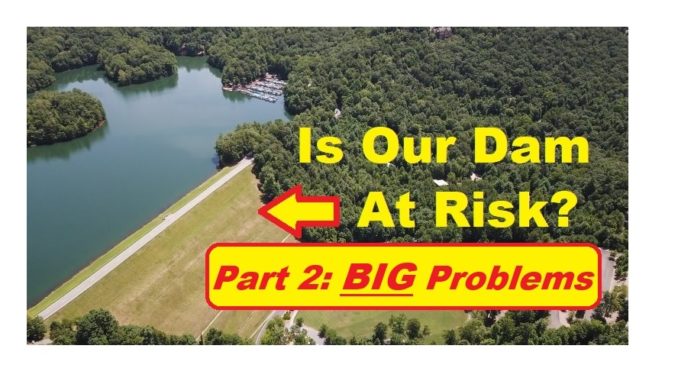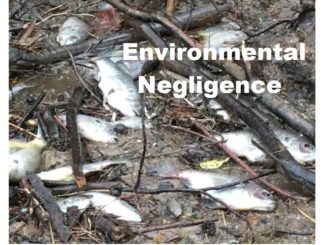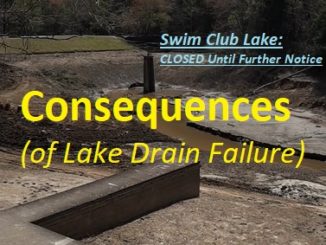
All Regional Residents (Big Canoe, Marble Hill, East Pickens County, and Ballground) are urged to read Part 1 Of this Story if you have not already, because this developing story could impact everyone in the area. In the following Part 2 Article, this Newspaper reveals more information regarding the safety and condition of Big Canoe’s Lake Petit Dam.
ADVANCE OUTLINE OF FACTS IN PART 2:
In Part 1, Records Requests made to the State of Georgia and to the Big Canoe POA were shared. In Part 2 we update on responses. (A) The Big Canoe POA has refused to comply with requests for information, stating in an Aug 14 2020 letter from the POA Attorney that members “are not entitled to demand to review or inspect the documents”. (B) The State of Georgia on the other hand, has begun the process of providing information. They have released the most recent March 9, 2020 Geosyntec Engineering Report (61 Pgs). It shows some concerning developments that are obviously the basis for the recently escalating inspections. (C) A review of almost 400 pages of Open Records indicates that Lake Petit Dam was determined NOT stable against an earthquake in 1998, and to date that situation has not been rectified. (D) Summary of Historically Proposed, and Potential Outcomes.
ARTICLE SECTION A:
As mentioned above, the POA is actively blocking Property Owner access to all documents that could provide transparency to the historical, and ongoing, situation with the Petit Lake Dam. Why the sudden secrecy? In a 2007 article titled “Lake Petit dam in good shape, GeoSyntec study report finds” (5), then POA President “Bob Crouch” concluded his article with the following, “The complete report is available at the POA Lodge for interested property owners to review.”
Back for a repeat performance in 2020, that same POA President “Bob Crouch” now hides behind the high-paid POA Attorney in regards to this year’s Geosyntec Report. It is exactly this sort of non-transparent hypocrisy that concerns so many Property Owners. As expected however, the POA did recently respond. But they have done so in their usual manner…. issuing generalized statements attempting to dismiss all concerns – but doing so in a “Trust Us, but Don’t Bother To Verify” fashion. Here is an August 2020 Board Meeting Transcript, of POA General Manager Scott Auer, addressing issues about the Lake Petit Dam.
I am not going to directly comment or respond to Mr Auer’s comments, except to say…. continue reading.
ARTICLE SECTION B:
Unlike the POA, the State of Georgia quickly responded to my Open Records Request with actual data, by providing the full 61 page Geosyntec Inspection Report from March 9, 2020. There are a several main takeaways of concern.
B1. The 2020 Study reports that Core Water Levels (Phreatic Line) within the Dam have risen since 2015, and have been “larger than previously recorded fluctuations”- recently and suddenly rising over 8 feet in some internal areas. Levels are currently even higher than in 1998, which triggered extreme concerns back then, including proposals to drain the lake. In the 1997 Summary of Initial Evaluation the following statements were made:
“Our primary engineering concern for this project has now shifted from the apparent seepage phenomenon to a more serious concern about the impact of a relatively shallow water surface level (phreatic surface) through the dam relative to overall stability……The primary effect of an elevated internal water surface within this dam would be a substantial decrease in stability safety factors….. These values are well below the Safe Dams’ design requirements, and raise some serious concerns about the potential stability of the existing dam structure.”
What was true in 1998, is true today, which is one reason we see sudden underwater investigations being triggered.
B2. There is increased seepage through the downward face of the dam, including a new area having grown to a section 6′ x 90′ in size in the lower center of the Dam, with other wet spots also noted. Adjacent areas also show establishment of “hydrophilic”, or water-loving, plants which is further indication of persistent water content in the soil. The increased water levels are principally indicated in a defined linear area running up through the central core of the Lake Petit Dam (an area that generally follows the path of the huge 30″ diameter “Lower Drain Pipe”, also known as the “Drawdown Pipe”, “Sluice Gate Pipe” or “Lake Drain Pipe”).
The primary concern here would be that a phenomena known as “Piping Failure” could be in the initial stages of occurring. Piping Failure doesn’t necessarily have anything to do with the large internal “Lake Drain Pipe”, nor smaller “Toe Drain Pipes” within the Dam, although blockage / damage to those could exacerbate the situation. “Piping Failure” is actually internal erosion caused by seepage. Think of this as a “progressive disease” in the health of a Dam, one that accelerates over time. The internal erosion forms along small channels (pipes), and then over time those channels increase in size. The more they increase in size, the faster seepage flow rates increase, which increases the channel size. The cycle repeats, and each cycle worsens the dam condition. Eventually the Core of the Dam is washed out and the internal structure of the Dam collapses. Here is a short video from the Association of State Dam Safety Officials that does a good job of visually explaining Piping Failure: https://www.youtube.com/watch?v=PC58mGG55io
The secondary concern with rising water levels (Phreatic line) within the Dam is that it makes the Dam more susceptible to Liquification, and therefore susceptible to Slide Failure. To save time, here is a brief, but excellent video explaining the concept: https://www.youtube.com/watch?v=BNFQ1EJX4h0 .
The recent changes that have been observed (increasing wet spot areas on the downstream face of the Dam, and the sudden larger than normal increase in internal “phreatic” water levels) are potentially leading indicators for either problem listed above. The fact that Lake Petit Dam is 48 years old, approaching an earthen dam’s 50 year design life cycle (6) tends to further validate the possibility that a problem is developing. Here is how one study described the end cycle of a Dam’s life:
“The average life expectancy of a dam is 50 years…. The decision of whether or not to remove a dam is made based on the ability to remedy the deficiencies that could cause failure. Economic issues can also drive dam removal…. older dams require more frequent maintenance and incur higher costs to repair and operate. In certain circumstances, it may benefit the community economically to remove a dam (Maclin & Sicchio, 1999, 16).”
B3. The drainage system is experiencing low flow, and signs of clogging and maintenance neglect are evident. Suffice it to say that proper drainage is critical to lowering the Phreatic Line (Water Levels) inside the Dam, and this could be contributing to the start of irreversible conditions such as noted in Sections B1 & B2 above. We are going to cover “Owner Maintenance Neglect” in separate future Articles, Part 3 or 4.
B4. There has been a negligence of timely data monitoring, which leaves big blank spots in the data, making accurate interpretations more difficult. The current Lake Petit Dam Piezometers (instruments used to measure internal water levels within the Dam) were installed in 1998, are 22 years old, have a history of anomalous readings, and according to the March 2020 Geosyntec Report, PZ’s “have not been monitored on a regular basis (other than at periodic inspections) since their installation in 1998.” The bottom line here is that due to lack of consistent monitoring by the POA, and subsequently a lack of comparative data, we are now partially flying blind as to what is happening internally within the Dam. What we do know is that the internal “Phreatic” water levels within the Dam just suddenly rose to their highest ever recorded levels, and are “larger than previously recorded fluctuations” but due to the lack of consistent data, we don’t know exactly how fast or severe the changes might be happening.
B5. The Upstream Face of the Dam is deteriorated and requires new Rip Rap. Both “beaching” and erosion were observed in the March 2020 Engineering Report. They were first noted in a 2008 Inspection. They were then addressed again in 2013. Fast forward to 2020, and the Geosyntec Report appears to contain a “Cover-Your-Ass” section (Appendix C) which contains a 2013 letter from Geosyntec to Safe Dam Program authorities, in which Geosyntec verifies that the POA has had recommendations made concerning this, and that they intend “to initiate work in late 2013”. Yet here we are in 2020, the can kicked down the road, and the regulators seemingly looking the other way all this time. Again, the history of maintenance failures will be more fully covered in the upcoming Part 3 or 4 Articles.
What is “Rip Rap” and what is its purpose? Rip Rap is a rock layer placed over gravel bedding and a sand filter or geotextile fabric, and protects the upstream slope against erosion due to wave action. Without proper slope protection, a serious erosion problem known as “beaching” can develop on the upstream slope. What is “beaching” and why is it bad? Beaching is basically an erosion slide on the upstream side of the dam. (These are excerpts from: https://damsafety.org/dam-owners/upstream-slope-protection)
B6. The Spillway was noted to most likely need some minor maintenance (small cracks throughout), but “In general, the spillway was found to be in good condition” as it had undergone resurfacing back in 2009.
B7. A BIG PROBLEM.
The Primary Lower Drain (aka the “Drawdown Pipe”, “Sluice Gate Pipe” or “Lake Drain Pipe”) that runs from the deepest part if the Lake, through the center of the bottom of the Dam, was declared “Not Functional”.
What is “Drawdown” and why is it important? “Lake drains are an important part of ensuring the safety of your dam”, and provides “a method to lower the lake level in an emergency situation”; and further “Meets the requirements of state dam safety laws.” (These are excerpts from https://damsafety.org/dam-owners/lake-drains.)
The recent March 2020 report stated as follows:
“The intake for the low-level drawoff is not visible from the surface and could not be inspected. A plan should be put in place to inspect this underwater feature” and went on to say “The full pipe was unable to be inspected, however a plan should be put in place to inspect the length of the pipe.”
Another section of the report stated the following:
“2.5 Low Level Drain The low level drain is located at the bottom of the upstream pool. It was not possible to check the condition of the low level drain during the inspection. Geosyntec understands that this drain is not utilized during normal operations.“
The above statement, highlighted in red, is the understatement of the Decade! Or should I say 4+ Decades! The Sluice Gate Pipe has not been opened or tested in 45 years according to internal memos.
Here is an excerpt from a chain of letters in 2005 between the POA GM & the Safe Dams Program:
On January 25, 2005, your staff performed the annual inspection of Petit Dam. There was one task that we were asked to do during the inspection. The gate valve for Petit Dam must be opened at least twice a year, once with an inspector present. On May 16,2005, Big Canoe POA hired a dive team to inspect the gate valve that opens Petit Dam. The dive team followed the pipe starting from the bank. At ninety-four feet, the pipe disappeared into the silt. The gate valve is buried in four to six feet of silt. In addition, we videoed the entire process showing where the pipe disappeared into the silt. Upon discovering the problem, we feel that if the gate valve were to be opened after thirty years the possibility of not being able to shut it back off exists. This could possibly drain Lake Petit, which supplies the drinking water for the entire community.
….after 30 years……
That was in 2005. Let us fast forward to 2020 and now the gate valve that opens the Lake Drain Pipe hasn’t been opened in 45 years, and we get the sudden Inspection Announcement in the July 27 2020 POA Board Notes (9), which stated:
“The Dam in Big Canoe has been reported having conditions with soft spots/damp sites cited near the spillway. GeoSynTech has been contacted to research the conditions. This work will require decompression devices with the divers working some 99 feet down to uncover the inspection site under layers of sediment.”
This situation is being forced by the State and Engineers to be dealt with now, most likely due to the potentially deteriorating conditions. Everybody involved is now covering their butts. Opening and testing that Lake Drain System twice a year is part of the legal Permit General Conditions for Operation of a Dam. It hasn’t been done in 45 years.
B8. I want to make an additional observation on the Actual Pipe that runs through the center of the Dam as part of our Emergency Lake Drain system. It is a 30″ diameter pipe, and it also hasn’t been internally inspected for the past 45+ years. We have no idea if it has shifted, or how stable the joints are. Assuming that they are even able to clear the many feet of sediment that covers the opening to the Lake Drain Pipe (100′ below the surface of Lake Petit), and open the Sluice Gate – can you imagine what the force of water traveling through those pipes (of unknown condition) for the first time in 45+ years could do? Just a few exposed weak spots could literally rip the guts out of our Dam, and cause a total Dam failure. If you want to imagine the power and force of water that would be dealt with, imagine the following video segment on just a slightly smaller diameter scale….. https://youtu.be/ze5MP9w_6Gc?t=35
Also, here is an excellent overview of the importance of having operable draw down systems (aka the Lake Drain): https://damfailures.org/lessons-learned/all-dams-need-an-operable-reservoir-drain-system/.
ARTICLE SECTION C: ANOTHER BIG PROBLEM.
The Lake Petit Dam does not meet minimum regulatory stability requirements against a seismic event, and this knowledge goes back a long way, and has caused immense concern. Yet, astoundingly, nothing was ever done to resolve the concerns. Here is an excerpt from a May 29, 1997 eval letter from one of our original Engineering Consultants:
“Both of these analyzed safety factors are well below the minimums required for a Category I dam in this state, with the seismic evaluation actually indicating failure of the downstream slope during a design seismic event. As with the idealized as designed configuration, all of the failure surfaces analyzed are deep and mobilize the majority of the downstream slope. Therefore, these represent massive slope failures.”
Listen to how serious they sound in a February 2, 1998 letter from the head of the Georgia Safe Dams Program,
“…it appears the dam currently has a steady-state safety factor of around 1.28 and a seismic safety of .75. Neither of these meet the current required minimum safety factors as outlined in the Rules for Dam Safety…. We are concerned about the dam not meeting the stability requirements especially in view of the size of this dam. Therefore, we believe every effort must be made to address this issue as soon possible….. The Safe Dams Program is not comfortable with the dam continuing in its current condition for at least another year.”
Here is the real kicker. In a May 19 2009 email communication from the Director of the Georgia Safe Dams Program to Roger Klask (GM of the Big Canoe POA) the following statement was made:
An additional and important item to mention is the stability of the dam. Several years ago a question came up about the stability. Engineers were hired and they evaluated the dam and determined it was stable during most situations, except for a seismic event. The fix was going to be well over a million dollars. A different firm was then retained who came up with a different approach. Their approach was new to the Safe Dams Program and so there was some educating back and forth. Ultimately, for whatever reasons, this situation has just been put aside, and it is still unresolved. In summary, there are three areas that need to be addressed with the dam 1. wave action erosion 2. spillway system 3. stability.
(2009!)
Summary: In 1997/98 they were seriously concerned, but nothing has ever been done. I can only imagine that the increased water levels within the our aging Dam’s internal structure, and the fact that our Emergency Lake Drain is “Not Functional” only increases the Risk of catastrophic failure now. At this point, I do not believe that ANYONE can realistically state that the Dam is safe from any type of seismic event.
I am not saying that the above WILL happen. I am saying that the Dam doesn’t currently meet the minimum Safety Requirements as required by the conditions of Operational Permit, and it COULD happen at any time. I am also saying that if they FORCE us to fix the Dam and bring it up to Code, then it is going to cost a lot of money.
ARTICLE SECTION D:
For the sake of argument in this Section, we are going to assume that the POA is the “Legal Owner & Operator” of the Lake Petit Dam. (The reality is that the issue is a bit muddy due to the Chain of Deeds, Title Exceptions, Water Easements, etc – but that will be addressed in a later article).
D1. Quick Summary: Our Aging Dam is showing leading indications that internal stability is further eroding. If anything goes wrong that requires the lake levels to be lowered, or drained, in order to quickly alleviate pressure in the Dam, or to do substantial repairs, we have no way to utilize our “Lake Drain Pipe” at present because the structural and operational soundness of doing so is in question. Due to the Age of the Dam; the sudden increase in concerning indicators; and the number of eyeballs on this thing – this is about to get expensive, because I believe that the Regulators are about to force the POA to undertake some very disruptive and expensive repairs, which will most likely be the same solutions discussed in a January 27, 1998 Memorandum of Meeting, of which here is the most likely scenario:
“The alternative of cutting into the existing dam was discussed. This alternative would probably require the draining of the lake and keeping it drained during a construction period of 6 to 8 months.-
It was suggested by the Big Canoe Developer’s own Engineers, CRW (which actually designed and built the Lake and Dam) in an August 19, 1998 Phone Log, that there was an even bigger problem looming if they drained the lake, stating the following:
“He (CRW Design Engineer, Tom Robertson) asked about lowering the lake slowly because of a concern of slope failures around the shoreline due to very steep cut slopes. Some may affect foundations of houses around the shore.”
D2. So How Expensive Could Repairs get? The Dam was built in 1972 dollars for a mere $800,000. The estimates that are in the POA “Hypothetical and Unfunded Budgets” is for $3,550,000 – but that estimate is 13 – 22 years old (POA won’t disclose exact source). Realistically the costs would far exceed that in 2020. I do know that until the Dive Inspection is completed, and an Engineering Plan / Estimate finalized, I don’t think the POA should be considering non-essential projects. Even at the decades old estimated numbers there isn’t nearly enough money in our Reserve Fund. In 2020 dollars who knows how much this could cost.
D3. How Disruptive could this be? We need to start by reminding the reader that this is the 2nd largest earthen Dam in Georgia, and is classified as a Category 1 High Hazard Dam. That categorization comes with strict adherence to legal regulatory requirements – which up until now have been ignored. One of those requirements is that the Lake Drain must be operational. If that Drain needs replacing, or serious repair – that means that Lake Petit will be drained. If the entire pipe needs replacement, that means the entire Dam will have to be deconstructed in the center, to a depth of about 135 feet below the peak. They will basically dig out the Dam to a level about 10 feet lower than the Ballfield (the level that the Lake Drain Pipe exits in the side culvert). NONE of this has even been accounted for in the earlier estimates, although they did say that just a minor digging into the Dam could leave it drained for 6 – 8 months. One of the things I don’t think anyone has thought of yet – is the possibility that if we have to tear into the Lake/Dam to fix it – will the Regulators even let us build it back at the current height? What if they make us lower it? Lake Petit Shorelines would greatly expand as the lake shrinks. Regulations have gotten stricter since 1972. We are ALREADY not to code. I believe that they may very well do that. Another fix they suggested involved a “thicker Dam” that pushed itself all the way into the ballfield, engulfing the roadway. That would forever change that area. One of these things is very likely to happen – AND cost a lot of money. Be clear about this – there are no good solutions here.
D4. What are the consequences of ignoring this and kicking the can down the road again?
Based on what I am seeing, I don’t think that is going to be an option. The Dam is getting older. Just like people get older and things stop working – such is the case with a Dam. There is too much concern and too many eyes on this. My guess is that the POA is going to be forced to deal with this, and it is going to get “Damn Expensive”. (pardon the pun)
This is a perfect stopping point, to allow people to absorb the issues related to the actual Safety, Structural & Financial Repair Issues of the Dam. Our next Articles (Part 3 & 4) will go into the Ownership Issues; Historical Issues of Neglect & Regulatory Violations; Liability Issues; Insurance Issues.
CLOSING QUESTION: What do you think of the validity of the POA’s comments on this matter now? Again, here is the August 2020 Board Meeting Transcript, of POA General Manager Scott Auer, addressing issues about the Lake Petit Dam. At least I offered documented facts to support my article. The POA won’t even share the engineering reports, paid for with property owner dues, with the property owners.
Peace,
– david / publisher
Focus on Big Canoe, GA
* a publication of The Mountains Voice
References:
(1) Open Records Request to State of Georgia EPD
http://bigcanoe.themountainsvoice.com/wp-content/uploads/2020/08/ORR-0024_GaEPD-SeekingLakePetitDamSafetyRecords-2020-08-112.pdf
(2) Records Request to Big Canoe POA
http://bigcanoe.themountainsvoice.com/wp-content/uploads/2020/08/RecordsRequestToGMandBoard-2020-08-11LakePetitDam.pdf
(3) POA Attorney Response to the Records Request to Big Canoe POA
http://bigcanoe.themountainsvoice.com/wp-content/uploads/2020/08/RecordsRequestToGMandBoard-2020-08-13LakePetitDamRESPONSEhilite.pdf
(4) Geosyntec Report on March 9 2020 Dam Inspection (61 Pgs)
http://bigcanoe.themountainsvoice.com/wp-content/uploads/2020/08/20-03-09_LakePetitEngineerInspectionGeoSyntec.pdf
(5) Bob Crouch’s March 2007 SS Article “Lake Petit dam in good shape, GeoSyntec study report finds”
http://bigcanoe.themountainsvoice.com/wp-content/uploads/2020/08/2007_LakePPetitDamInGoodShapeGeoSyntecStudyReportFindshilite.pdf
(6) 50-year service – https://www.usace.army.mil/Media/Fact-Sheets/Fact-Sheet-Article-View/Article/590578/dam-safety-facts-and-figures/
(7) 50 year end of life quote – http://web.mit.edu/12.000/www/m2012/finalwebsite/problem/dams.shtml#demo
(8) 2005 Letters about Sluice Gate Drain
http://bigcanoe.themountainsvoice.com/wp-content/uploads/2020/08/BC-LPD_2005_LettersAboutLowerDrainFailhilite.pdf
(9) See “July 27 2020 POA Board Notes” attachment link in the Fri, Aug 7, 2020 eblast from the POA entitled “Board Work Session Thursday, August 13”
(10) Permit General Conditions for Operation of a Dam
http://bigcanoe.themountainsvoice.com/wp-content/uploads/2020/08/GeneralConditionsForOperationOfADamw-note-on-drain-test.pdf
(11) 2009 Email from GSDP to POA GM
http://bigcanoe.themountainsvoice.com/wp-content/uploads/2020/08/BC-LPD_2009-05-19_WoosleyToKlaskDamNotStablehilite.pdf
(12) May 29, 2007 Preliminary Evaluation Letter
http://bigcanoe.themountainsvoice.com/wp-content/uploads/2020/08/BC-LPD_1997-05-29_ReportOfPrelimEvalPGC2JJGhilite.pdf
(13) February 2 1998 Letter about seismic requirement failure
http://bigcanoe.themountainsvoice.com/wp-content/uploads/2020/08/BC-LPD_1998-02-02_FailedMinimumSeismicLetterSPD2POAhilite.pdf
(14) January 27 1998 Memorandum Of Meeting
http://bigcanoe.themountainsvoice.com/wp-content/uploads/2020/08/BC-LPD_1998-01-27_MemorandumOfMeetingCRW2POAHILITE.pdf




Be the first to comment